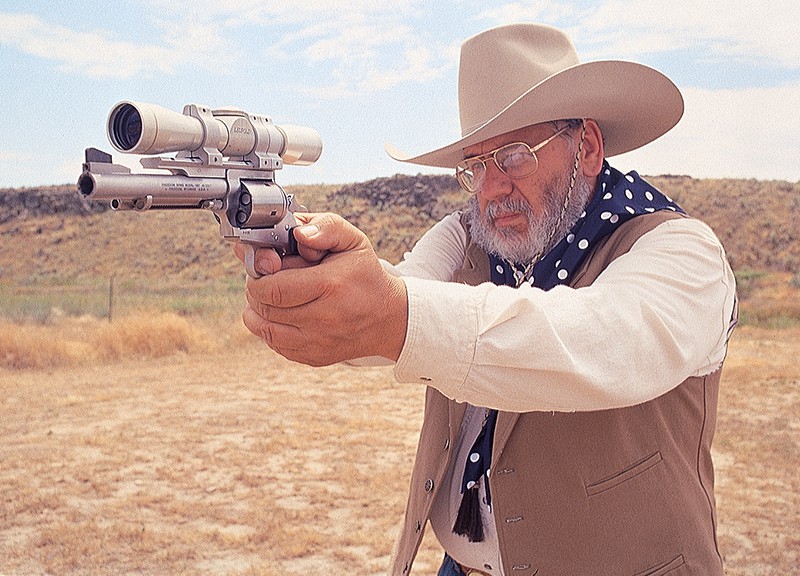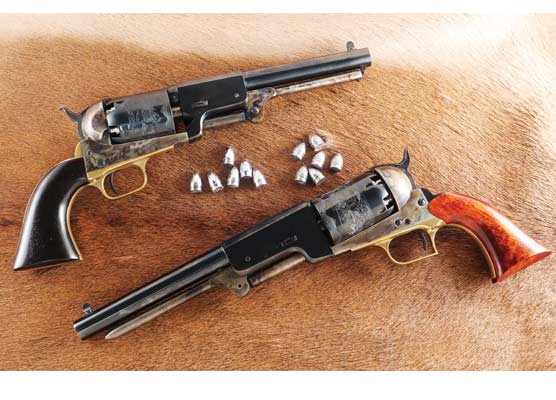A couple of years ago, Pachmayr produced an aluminum competition speedloader that also releases rounds when the knob is turned, although in the opposite direction of my HKS models. It takes a little getting used to, but this loader is as rugged as they come.
Safariland also makes speedloaders, and back in the 1970s, I can recall my pals in law enforcement were hot on loaders produced by Dade, which were designed so the user pushed a center button rather than twisted it. Dades are no longer manufactured, but one can still occasionally find them used on some of the auction forums.
A few years ago, I bought a Model 57 S&W and one detail that sweetened the deal was the gun came with a pair of HKS No. 57 speedloaders. I already had a couple, and these simply augmented my supply. I carry them in the cargo pockets of my parka or insulated vest, and they’re always handy when they’re needed.
Speedloaders make
sixguns sizzle
Feel Need for Speed!
Well into the last century, when my preferred carry guns were revolvers and I used them in local competitions, there were always spare rounds within easy reach. Ultimately I set aside belt slide cartridge carriers or dump pouches and started packing speedloaders.
You can often find them advertised in the pages of GUNS or American Handgunner and other firearms periodicals. They’re inexpensive, but in an emergency, they are priceless. In the days when police officers and sheriffs’ deputies carried revolvers, many if not most eventually carried speedloaders as they became more popular.
In competition, practice helped me immensely in 12-round relays to the point I could dump six empties and drop in fresh rounds in a couple of seconds. During one match I managed to fire, reload and empty my Colt Python a second time faster than a guy using a popular semi-auto was able to swap out magazines. (It surprised me more than anybody else, actually, and I doubt I could repeat that feat today.)
History tells us the concept of speedloaders for double-action or top-break revolvers dates back more than a century. Even in the day of black powder cap-and-ball revolvers, according to some articles I’ve read, a few ingenious folks carried a spare fully-loaded and capped cylinder to swap out in an emergency, typically with the Remington revolver models because they were much easier to work with than Colts of the day. This practice apparently began during the Civil War and continued into the early days of the Wild West before cartridge revolvers became prominent.
James Butler “Wild Bill” Hickok opted to carry two percussion revolvers, typically Navy Colts worn butt-forward either in a sash or in holsters. If only he hadn’t taken that chair in Nuttal & Mann’s No. 10 saloon, leaving his back vulnerable to Jack McCall.
When the double-action Model 1917 Colt and Smith & Wesson revolvers with their swing-out cylinders were used during WWI and WWII in lieu of Model 1911 pistols, soldiers armed with those guns carried spare loads in half- or full-moon clips. It was a fast way to stay in the fight on a battlefield, when and if the necessity arose.
My first experience with a speedloader came when a sheriff’s deputy pal gave me a round rubber cartridge holder to fit my Model 19 S&W. I believe Safariland made it and it was pretty clever. Spare rounds were held securely as the cartridge case heads fit into recesses molded into the six round slots. I lost it in the snow late one night while photographing a pretty gruesome traffic accident.
But it beat removing cartridges one a time from a belt, and offered a vast improvement over dump pouches, which occasionally contributed to dropping ammunition on the ground. It is possible to become very adept with speed reloads. It simply takes time at the range, practicing reloads.
Ultimately, I stepped up to HKS hard plastic speedloaders and I’ve never been sorry. A quick clockwise twist of the knurled center knob released six rounds of .357 Magnum into the empty chambers, and my sixgun was back in business. Cartridges are held in by small ridges on a metal center pin that turn into place grabbing the rims when the knurled knob is turned counter-clockwise. It’s a crafty setup and holds cartridges firm even when the loader is dropped.
For several years, my EDC has been a .45-caliber Colt Commander or Kimber Compact, but I’ve recently been carrying a 2 ½-inch Model 19 S&W snubby. It’s a classic from the early 1980s with the firing pin on the hammer and it remains as accurate and controllable as ever, even with full house loads. The double action is smooth, and when fired single action, the trigger breaks clean.
Maybe it’s a “retro” thing, or I simply prefer to be different, but round guns have been protecting people for more than 150 years and are still formidable defensive tools. Besides, I don’t plan to miss a lot.
I was delighted when Colt revived the Cobra, King Cobra and Python — making some slight but significant improvements to each model in the process — and revolvers from S&W, Ruger, Taurus and Kimber are as good as they come. I still have my Python from about 40 years ago, and with it a couple of reliable speedloaders. Ditto for my Diamondback, a model I also wish Colt would resurrect along with the Detective Special. Both were classy and reliable in their day, and represent a classic period in handgun history.
If you buy one of these updated classics, get some speedloaders. Learn to use them. They might just become lifesavers.










